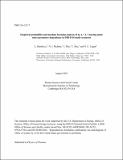| dc.description.abstract | m, n = 2, 1 tearing mode onset empirical probability and machine learning analyses of a multiscenario DIII-D database of over 14 000 H- mode discharges show that the normalized plasma beta, the rotation profile, and the magnetic equilibrium shape have the strongest impact on the 2,1 tearing mode stability, in qualitative agreement with neoclassical tearing modes (m and n are the poloidal and toroidal mode numbers, respectively). In addition, 2,1 tearing modes are most likely to destabilize when n > 1 tearing modes are already present in the core plasma. The covariance matrix of tearing sensitive plasma parameters takes a nearly block-diagonal form, with the blocks incorporating thermodynamic, current and safety factor profile, separatrix shape, and plasma flow parameters, respectively. This suggests a number of paths to improved stability at fixed pressure and edge safety factor primarily by preserving a minimum of 1 kHz differential rotation, increasing the minimum safety factor above unity, using upper single null magnetic configuration, and reducing the core impurity radiation. In addition, lower triangularity, lower elongation, and lower pedestal pressure may also help to improve stability. The electron and ion temperature, collisionality, resistivity, internal inductance, and the parallel current gradient appear to only weakly correlate with the 2,1 tearing mode onsets in this database. | |
